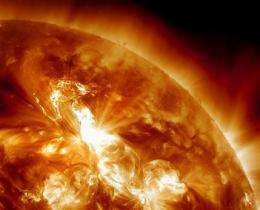Solar storm expected to fire up northern lights

Stargazers were out in force in northern Europe on Tuesday, hoping to be awed by a spectacular showing of northern lights after the most powerful solar storm in six years.
Even before particles from that storm reached the Earth on Tuesday, the aurora borealis was dancing across the sky as far south as Ireland and England, where people rarely get a chance to catch the stunning light show.
"The lights appear as green and red mist. It's been mostly green the past few nights. I don't know if that's just special for Ireland," said Gerard O'Kane, a 41-year-old taxi driver and vice chairman of the Buncrana Camera Club in County Donegal in Ireland's northwest corner.
He and at least two dozen amateur photographers were meeting after dark at a local beach for an all-night stakeout. They've been shooting the horizon from dozens of locations since Friday night.
An aurora appears when a magnetic solar wind slams into the Earth's magnetic field, exciting electrons of oxygen and nitrogen.
The northern lights are sometimes seen from northern Scotland, but they were also visible Monday night from northeast England and Ireland, where such sightings are a rarity.
Those auroras were likely just variations in normal background solar wind, not the solar storm that erupted Sunday, said physicist Doug Biesecker at the U.S. Space Weather Prediction Center in Boulder, Colorado.
He said a geomagnetic storm Tuesday that came from that solar storm seemed to mostly miss Earth, going a bit north, so it was unlikely that auroras would extend too far south Tuesday night.
While the geomagnetic part of the solar eruption - which happened around 11 p.m. EST Sunday - was more of a fizzle, another earlier part of the sun's outburst was more powerful.
On Monday and Tuesday, the proton radiation from the eruption reached strong levels, the most powerful since October 2003. That mostly affects astronauts and satellites, but NASA said the crew on the International Space Station was not harmed and only a few minor problems with satellites were reported, Biesecker said.
On the northern edge of Europe, where auroras are common, the sky lit up after nightfall Tuesday. A webcam from Abisko, northernmost Sweden, showed bright bands of green sweeping across the starry sky.
Aboard the M/S Midnatsol, a cruise ship plying the fjord-fringed coast of Norway, British astronomer John Mason said the lights danced around in "fantastic structure" Tuesday evening.
"We had green arcs with rays going up in the sky. And because we were underneath them, they were making all kinds of shapes in the sky. One looked like a heart," he said. He was expecting an even stronger display later Tuesday or early Wednesday, as Sunday's solar flare kicks in with full force.
Geomagnetic storms cause awesome sights, but they can also bring trouble. According to the National Oceanic and Atmospheric Administration, problems can include current surges in power lines, and interference in the broadcast of radio, TV and telephone signals. No such problems were reported Tuesday.
Scientists have been expecting solar eruptions to become more intense as the sun enters a more active phase of its 11-year cycle, with an expected peak in 2013.
But in recent years the sun appeared quieter than normal, leading scientists to speculate that it was going into an unusually quiet cycle that seems to happen once a century or so.
Peter Richardson, a 49-year-old bar manager and part-time poet at the 17th-century Tan Hill Inn in northern England, said the pub - normally dead on a Monday night in January - was thronged until the wee hours of the morning with people who came to look at the lights.
"I just thought: 'Oh my God, this is just absolutely amazing,'" he said. "You do get a lot of spectacular skylines out here, but that was just something out of the ordinary. Very different."
Ken Kennedy, director of the Aurora section of the British Astronomical Association, said the northern lights may be visible for a few more days.
The Canadian Space Agency posted a geomagnetic storm warning Tuesday after residents were also treated to a spectacular show in the night sky.
©2012 The Associated Press. All rights reserved. This material may not be published, broadcast, rewritten or redistributed.




















